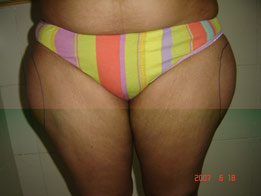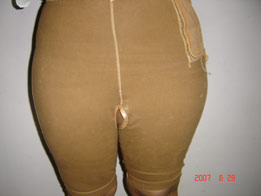|
Lipectomy means
removal of fat by surgery. In lipolysis, the surgeon loosens and
removes the fat from an area by using long or short metal tubular
instruments connected to a suction machine . The suction tubes are
usually made of stainless steel. The tips are blunt. The tubes
have 1 to 5 holes near the tip on one side or on different sides.
The suction machines used for this purpose create very powerful
negative pressures (1 torr to 35 torr at sea level). Lipolysis was
started in France in late 70's and since 1981 is in practice in
the United States and other parts of the world.
Fat collections of the Hips,
Thighs, Buttocks, Abdomen, Arms, Under the Chin, Upper Torso,
etc., can be reduced by this procedure.
Can one's weight
be reduced by this operation? Who is a good candidate for
Lipolysis? Lipolysis is neither a substitute for dieting, nor a
cure for obesity. Persons with reasonably normal weight and
healthy elastic skin with extra localized fat in certain areas,
get the best results from this procedure. (Healthy elastic skin
has the capacity to shrink after the surgery). Even though
Lipolysis can be done on patients upto 40 to 50 years of age, it
is not normally done if the skin is loose in the particular area.
One could have loose skin after losing a lot of weight or after
the pregnancy or due to ageing. In these patients, in addition to
Lipolysis, some of the skin should also be removed, to get a
satisfactory contour.
|
A case of
liposuction |
|
Before operation |
|
After operation |
 |
|
 |
The fat cells
that are removed are removed for ever and do not come back again.
Most of the fat cells are situated under the skin. A total number
of fat cells present in a person's body does not increase as one
grows older or when one gains weight. When a person gains weight
the size of the fat cells increases as more fat is being deposited
in it. When one loses weight, the fat is mobilised out of the fat
cells and so these cells become smaller in size. Only liver and
skin have the capacity to regenerate in the human body. Fat cells
cannot regenerate or multiply. And so, the fat cells that are
removed are removed for ever.
Surgical
Procedure :
A small cut about
4 mm to 10 mm is made, a few inches away from the area to be
suctioned and the suction cannulae are inserted. The cuts are
usually made in the skin folds and so, the scars are not much
noticeable. Depending upon the areas to be suctioned and
recontoured or reduced, anywhere from 600 gms to 6000 gms of the
material is removed in one sitting - If more material is removed
blood transfusions may be required.
After The
Surgery :
After the
surgery, snug or tight dressings will be applied for 5 to 8 days
to promote the shrinkage of the skin and to minimize the swelling.
In most instances one is required to wear a support or a girdle
for several weeks or months during the healing time. One could
feel localized areas of hardness or firmness in the suctioned
areas for 1 to 4 months after the surgery.
One may require
oral pain medication for one to two days after the surgery. During
the healing period, numbness or discomfort could be present for a
varied periods of time. After the surgery, there will be swelling
in the areas of the surgery. Even though most of the swelling has
gone in the first 2-3 weeks, it takes 2-4 months for all the
swelling to be gone. Discoloration could last upto several weeks
after the surgery.
Even though the
patient is required to stay only one day in the hospital, one
should stay within the close reach of my office for about 10 days,
for follow up care. Even after multiple area lipolysis one should
be able to be up and around in 1 to 2 days and back to most of the
normal activities in 10 to 14 days.
Results :
Results depend
upon the expectations of the patients and the amount of fat that
is suctioned from the given area. Usually patients with good
elastic skin and who come for recontouring a particular area are
very happy. Older patients and patients with over weight could be
unhappy. Perfection and symmetry are not possible in every
patient. Also in some patients, all unwanted fat cannot be removed
in certain areas in the first sitting. On these patients, the
lipolysis may have to be repeated. But, a second lipolysis cannot
be done until all the swelling is gone from that particular area
(i.e. about 4 months)
On rare occasions, rippled or
uneven skin or areas of loose skin could result from this surgery,
which might require further surgeries to correct them.
|